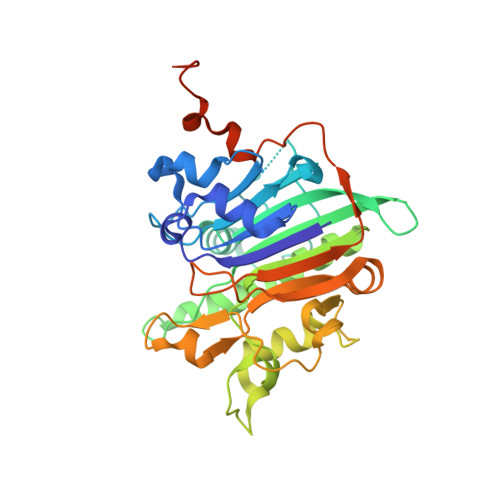Endogenous DNA 3' Blocks Are Vulnerabilities for BRCA1 and BRCA2 Deficiency and Are Reversed by the APE2 Nuclease.
Alvarez-Quilon, A., Wojtaszek, J.L., Mathieu, M.C., Patel, T., Appel, C.D., Hustedt, N., Rossi, S.E., Wallace, B.D., Setiaputra, D., Adam, S., Ohashi, Y., Melo, H., Cho, T., Gervais, C., Munoz, I.M., Grazzini, E., Young, J.T.F., Rouse, J., Zinda, M., Williams, R.S., Durocher, D.(2020) Mol Cell 78: 1152
- PubMed: 32516598
- DOI: https://doi.org/10.1016/j.molcel.2020.05.021
- Primary Citation of Related Structures:
6WCD - PubMed Abstract:
The APEX2 gene encodes APE2, a nuclease related to APE1, the apurinic/apyrimidinic endonuclease acting in base excision repair. Loss of APE2 is lethal in cells with mutated BRCA1 or BRCA2, making APE2 a prime target for homologous recombination-defective cancers. However, because the function of APE2 in DNA repair is poorly understood, it is unclear why BRCA-deficient cells require APE2 for viability. Here we present the genetic interaction profiles of APE2, APE1, and TDP1 deficiency coupled to biochemical and structural dissection of APE2. We conclude that the main role of APE2 is to reverse blocked 3' DNA ends, problematic lesions that preclude DNA synthesis. Our work also suggests that TOP1 processing of genomic ribonucleotides is the main source of 3'-blocking lesions relevant to APEX2-BRCA1/2 synthetic lethality. The exquisite sensitivity of BRCA-deficient cells to 3' blocks indicates that they represent a tractable vulnerability in homologous recombination-deficient tumor cells.
- Lunenfeld-Tanenbaum Research Institute, Mount Sinai Hospital, 600 University Avenue, Toronto, ON M5G 1X5, Canada.
Organizational Affiliation:




















